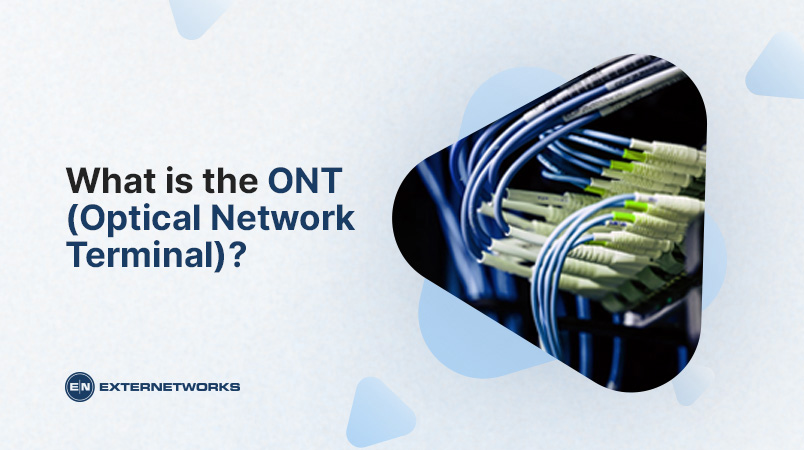An ONT is also known as an optical network terminal. Optical networking is data transmission through fiber optic cables, and the ONT converts the light signal into an electrical signal. An ONT is usually installed at the edge of a local or wide area network.
An Optical Network Terminal (ONT) is a device that communicates with other devices on an optical network using light waves. It converts data from digital to analog form, and vice versa then sends it across the network. The term “optical” refers to the fact that these networks use light waves instead of electricity as their transmission medium.
There is another fiber technology to be aware of, but we concentrate on ONT here. The other acronyms are:
A PON consists of an optical line terminal (OLT) at the service provider‘s central office and many optical network units (ONUs) near end users.
An ONT needs to convert the light pulses from the fiber optic cable into electrical signals to ensure that your data gets to its final destination. Then, the ONT sends these signals to your Fiber router or cable modem router to route the data to the correct location.
An ONT is a translator. The ONT receives optical signals from the fiber optic cable and converts them into electrical signals. These electrical signals travel across the house or office building and eventually reach your router or modem. Once your router or modem recognizes the ONT’s unique ID, it knows how to route the data to the correct location.
When you connect to the Internet with your computer, the modem in your home provides a connection to the Internet Service Provider. Your computer uses this connection to send information to the ISP, and that’s when the modem sends the request to the ONT.
When the ONT receives the request, it takes the information from the modem and converts it into an optical signal. Then it sends the signal down the fiber optic cable to the central office where the fiber runs out. At the central office, there are other devices called optical splitter boxes. These split the incoming signal into individual lines, and each line goes to a different customer. The splitter box sends each line to its destination.
Once all the lines have been sent to their destinations, they’re combined again by another splitter box before going back to the central office. The signal is converted back into an electric one and sent to the modem.

There are several benefits of having an ONT in your home.
First, you don’t have to pay for a service to get online; you’ll only need to pay for the broadband package you already subscribe to. Second, you won’t have to run out of bandwidth during peak hours. You can access the web anywhere in your house.
Most people don’t realize it, but when you use your computer or smartphone online, you connect to another person’s computer. The data travels with a series of cables known as “optical fibers.” While these cables look invisible, they’re made out of glass fibers.
Each glass fiber connection carries billions of bits of information every second. When you access websites, send emails, or stream videos, all those bits of information must be transmitted along with the same fiber. This means that the speed at which you receive data depends on the number of other users connected to the same fiber.
Fiber networks are both faster and can provide symmetrical upload and download rates for those who create or conduct business online.
With an ONT, you’ll have more bandwidth than any user could consume. Instead of sharing the limited bandwidth with everyone else, you’ll
Get exclusive access to the entire pipe. A typical broadband connection uses about ten megabits per second (Mbps) bandwidth. With an ONT, you get up to 100 Mbps of bandwidth. That means you can download a movie in just seconds!
When you use Wi-Fi to connect to the Internet, your wireless signal travels through space where there are no wires, making it easy for hackers to intercept your data. You can protect yourself against these attacks by installing an ONT because your data travels along a much longer path.
Hackers won’t be able to break into your system without first breaking into the ONT, and once they’ve done so, they won’t be able to see what you’re doing until they find their way back to the ONT.
If you’re already paying for high-speed Internet service, you may be able to save money by adding an ONT instead of upgrading your existing modem.
If you’re looking to buy a new modem, you might consider getting an ONT. You can typically get a good deal on an ONT if you purchase it directly from your ISP rather than a third party.
The ONT is a specialized piece of equipment used by ISPs to connect customers to the Internet. It’s not something most people will ever need to know about, but it’s important to understand if you’re considering buying one.
An ONT will allow you to enjoy faster speeds, better security, a cost-effective solution, and more flexibility. If you want to make sure you’re always connected to the Internet, ONT is definitely worth considering. The best thing about an optical network terminal (ONT) is that it allows you to stay connected even if you’re not at home. It works like a router, allowing you to connect multiple devices to the Internet.
